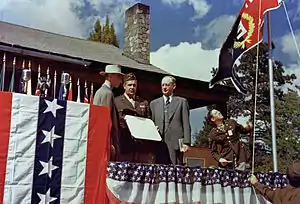Portal:Nuclear technology/Articles/19
The Los Alamos Laboratory, also known as Project Y, was a secret laboratory established by the Manhattan Project and operated by the University of California during World War II. Its mission was to design and build the first atomic bombs. Robert Oppenheimer was its first director, serving from 1943 to December 1945, when he was succeeded by Norris Bradbury. In order to enable scientists to freely discuss their work while preserving security, the laboratory was located in a remote part of New Mexico. The wartime laboratory occupied buildings that had once been part of the Los Alamos Ranch School.

The development effort initially concentrated on a gun-type fission weapon using plutonium called Thin Man. In April 1944, the Los Alamos Laboratory determined that the rate of spontaneous fission in plutonium bred in a nuclear reactor was too great due to the presence of plutonium-240 and would cause a predetonation, a nuclear chain reaction before the core was fully assembled. Oppenheimer then reorganized the laboratory and orchestrated an all-out and ultimately successful effort on an alternative design proposed by John von Neumann, an implosion-type nuclear weapon, which was called Fat Man. A variant of the gun-type design known as Little Boy was developed using uranium-235.
Chemists at the Los Alamos Laboratory developed methods of purifying uranium and plutonium, the latter a metal that only existed in microscopic quantities when Project Y began. Its metallurgists found that plutonium had unexpected properties, but were nonetheless able to cast it into metal spheres. The laboratory built the Water Boiler, an aqueous homogeneous reactor that was the third reactor in the world to become operational. It also researched the Super, a hydrogen bomb that would use a fission bomb to ignite a nuclear fusion reaction in deuterium and tritium.
The Fat Man design was tested in the Trinity nuclear test in July 1945. Project Y personnel formed pit crews and assembly teams for the atomic bombings of Hiroshima and Nagasaki and participated in the bombing as weaponeers and observers. After the war ended, the laboratory supported the Operation Crossroads nuclear tests at Bikini Atoll. A new Z Division was created to control testing, stockpiling and bomb assembly activities, which were concentrated at Sandia Base. The Los Alamos Laboratory became Los Alamos Scientific Laboratory in 1947. (Full article...)